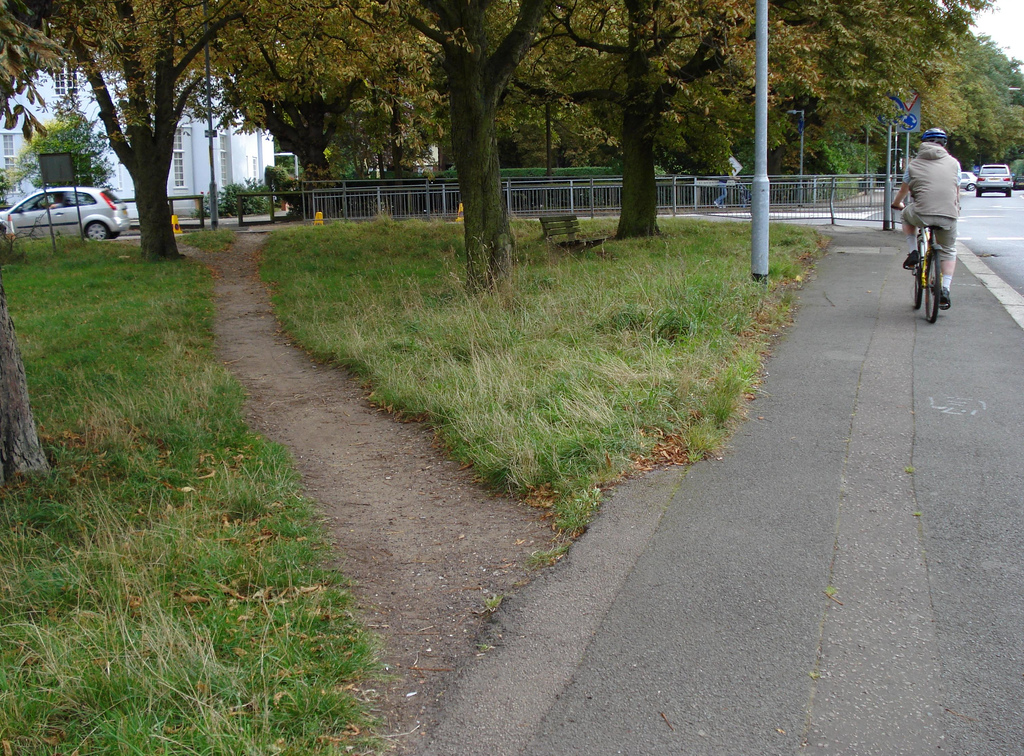Desire paths. I’ve seen them, and used them, and contributed to them countless times. Yet I never knew they had a name.
A desire path (also known as a desire line, social trail, goat track or bootleg trail) can be a path created as a consequence of foot or bicycle traffic. The path usually represents the shortest or most easily navigated route between an origin and destination. The width of the path and its erosion are indicators of the amount of use the path receives. Desire paths emerge as shortcuts where constructed ways take a circuitous route, or have gaps, or are lacking entirely.
That’s the Wikipedia definition. It’s the place where the expectations of a community conflict with the expectations of a design. Almost always, the community wins. The people win. Without significant enforcement costs, design alone will not dictate what people will do.
Smart urban planners use this to their advantage instead of fighting against it. In the most extreme form, they’ll build as little as possible when starting, and use the emerging desire paths to inform the build-out. In a more common form, they look to these paths when designing future improvements and renovating existing spaces. Smart product development teams can also incorporate this thinking into their own practices.
New Opportunity Spotting
A great way to spot opportunities for new businesses, or new products, is to look for the desire paths in existing products or industries. Remember our Wikipedia definition?
Desire paths emerge as shortcuts where constructed ways take a circuitous route, or have gaps, or are lacking entirely.
There are markets in those gaps. Can you find several companies that spend their own resources gluing two existing products together in a common way? That’s a desire path, and there’s a market there if you’re willing to build the sidewalk. In fact, IFFFT and Zapier are building businesses off that construct at a platform level.
Or perhaps you’ve heard countless examples of companies continuing to revert to email chains for status reporting and project management, even after trying numerous software products that were supposed to replace email. That’s a desire path – or perhaps a desire freeway with how widely used it is – and smart businesses are working with it instead of against it. IDoneThis is a great example of email-first status reporting. Square Cash allows you to send money over email. Even most traditional project management apps now allow thread discussions to happen over email. It’s a path our users already use frequently and are comfortable with - fighting against it would work as well as putting up a sign saying please stay on the sidewalk.
Embracing Desire Paths for Optimization
Unfortunately, teams aren’t always quick to embrace a desire path in their own product, like the reply-by-email feature discussed above. A more common response is to blame those creating the path. They’re not following protocol. They’re not conforming to guidelines. They’re not using our perfectly thought-out design. But in reality, it’s on us. Our design wasn’t perfectly thought out, because that very notion is a myth. It’s our fault for not accommodating the desires of the community. We need to learn to use, and embrace the paths are users are so clearly fond of.
Twitter as an Example
Twitter is a great modern example of using community behavior to inform product decisions. Think back to the history of the @reply. It was originally a desire path - not built into the design but used by the community. It became so common that it actually became a part of the community. Twitter didn’t fight this, and they didn’t try to design something better or new that they could claim as their own. They simply made the already common behavior an officially sanctioned one. They put down concrete to form a sidewalk where a desire path once was. Fulfills the same use, in the same way, just smooths the rough edges a bit.
Process Improvements
Observing desire paths doesn’t just end when thinking about your customer-facing products. It can be just as powerful when applied to your internal teams and processes. Is your sales team using the collateral you provide in the way you intended? If not, how are they using it and why? Does customer service send your customers to reference material on another site? Or maybe they show customers how to tap into product functionality in a way that was intended for internal use only? There’s a reason they’re resorting to these behaviors; they’re doing what’s best for the customer, and what’s best for them. By working to understand the reasoning instead of fighting the behavior, you can design new processes that are better for everyone.
It’s All About Observation
In the end, it’s all about observation. You can’t design in a vacuum. Real people will have real desires, and they’ll act on them whether or not it conforms to your best-laid plans. You’ll get a lot further by observing the behavior of others and facilitating that behavior than you will by trying to create everything from your own head.

